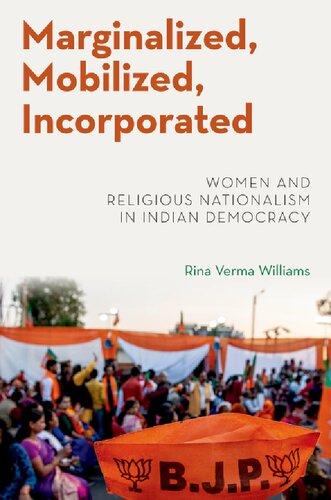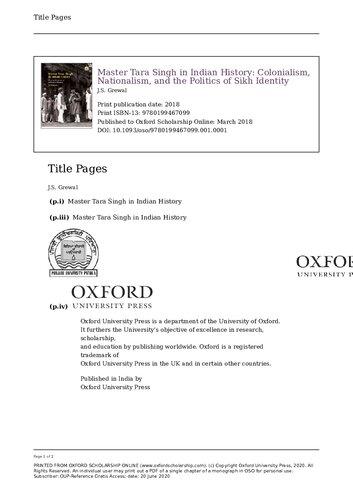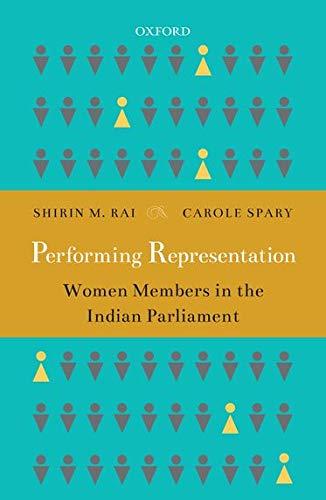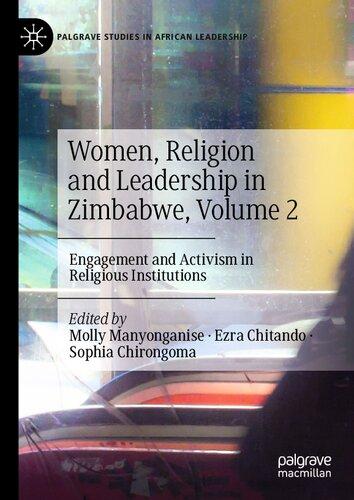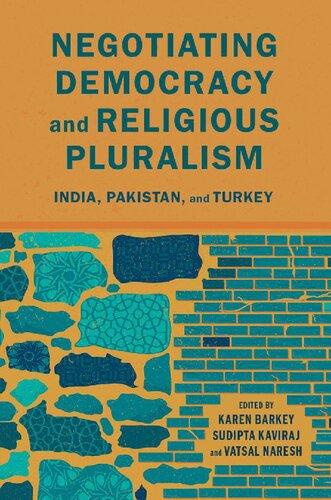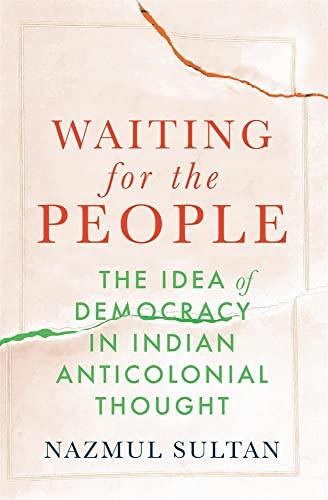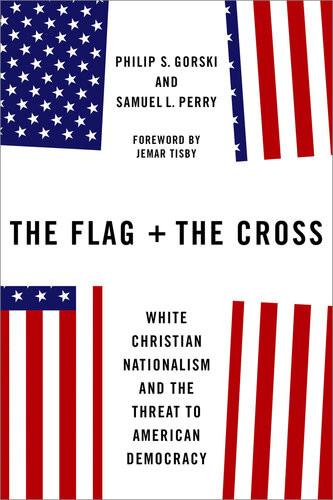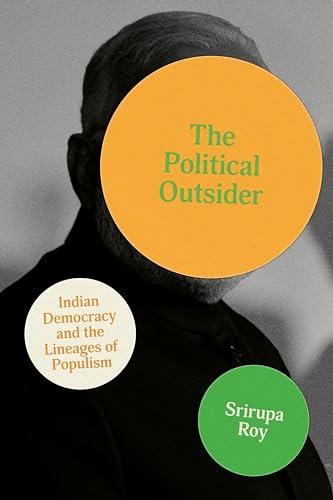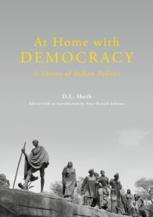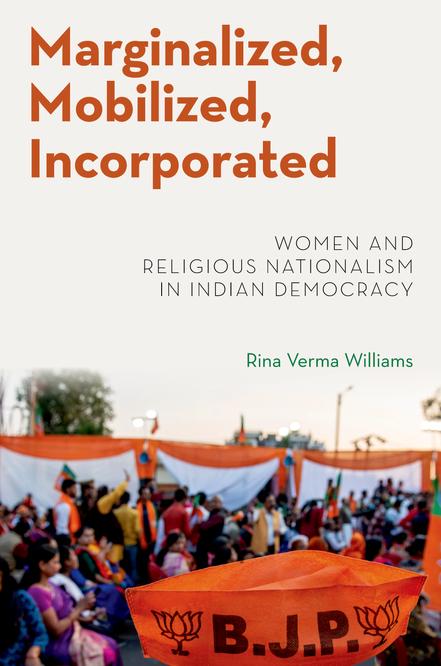Introduction
Women, Political Parties, and Indian Democracy
On December 6, 1992, thousands of Hindu nationalist kar sevaks (militant activist “volunteers”) converged on the Babri Masjid—a mosque built in 1527 in the northern Indian town of Ayodhya—and tore it down with crude tools like shovels and pickaxes, even tearing at it with their bare hands. Te mosque’s destruction sparked weeks of religious rioting around the country and shook the foundations of Indian secular democracy. Hindu nationalist women played very particular roles in these events: some exhorted Hindu men to violence against Muslim minorities to defend the faith and protect Hindu women; others literally cleaned up in the streets afer bloodletting had occurred.
Less than a year afer these events I arrived in India for dissertation feldwork.1 Te destruction of the mosque is commonly marked as a turning point that launched the political party of Hindu nationalism, the Bharatiya Janata Party (“Indian People’s Party,” or BJP), to national political prominence. Twenty years later—having returned specifcally to study the role of women in Hindu nationalist politics—I watched women, now shoulder to shoulder with men, milling about in the crowd and speaking on the dais at the BJP’s campaign kickof rally in New Delhi for the 2014 election, which the party won in a landslide that surprised even the most seasoned observers of Indian politics.
Tese two moments in modern Indian politics frame the core questions of this book: How has the participation of women in Hindu nationalist politics changed over time? And what does their changing participation mean—for women, for Hindu nationalism, and ultimately for Indian democracy?
Te growing role of women in Hindu nationalist politics has corresponded with Hindu nationalism’s rising political fortunes. But the benefts for women are less clear, as the BJP has expanded the role of women without signifcantly altering regressive gender ideologies that continue to tether women’s political voices to their societal roles in the home and family. Access to the public
Marginalized, Mobilized, Incorporated. Rina Verma Williams, Oxford University Press. © Oxford University Press 2023. DOI: 10.1093/oso/9780197567210.003.0001
sphere has expanded for some women, and this is not a negligible beneft in a society in which the public sphere remains heavily male dominated. But women’s increasing participation has not led to notable advances on women’s issues or women’s rights more broadly, and has corresponded instead with an expansion of the radical right-wing agendas of the party that are undermining Indian democracy.
Hindu nationalism (or Hindutva, which translates roughly to “Hinduness”) is at core an ethnic nationalism that holds that the only true Indians are those for whom the Indian subcontinent is both the land of their birth and the homeland of their religion: that is, followers of religions that originated in the subcontinent. Tis would include Hindus, Sikhs, Jains, and Buddhists,2 while excluding Muslims and Christians as well as Jews and Parsis (also known as Zoroastrians). In this way Hindutva virtually equates being Indian with being Hindu. Despite Hindus being an overwhelming majority in India (around 80 percent since independence in 1947, and about 75 percent in prepartition, preindependence India), Hindutva constructs Hindus as under perpetual demographic threat from minority religious groups.
Tis book focuses on the political parties of Hindu nationalism in India— including the All-India Hindu Mahasabha (or simply Hindu Mahasabha) and the BJP, its contemporary successor—to show how women have become increasingly involved in Hindu nationalist politics over time.3 I place women’s participation in religious politics in India into historical perspective by comparing three critical time periods: before, during, and since the party’s initial rise to national political power during the 1980s and 1990s. In its formative years in the early 1900s, before it initially rose to power, Hindu nationalist politics marginalized women. In the 1980s and 1990s, during its initial rise to power, the BJP began to mobilize them; and in the contemporary period, since its initial rise to power, it has institutionalized ways to incorporate women into its structures and activities. I argue that incorporating women into Hindu nationalist politics has signifcantly advanced the BJP’s electoral success compared to prior periods when women were marginalized or mobilized in more limited ways. For the BJP, women’s incorporation works to normalize religious nationalism in Indian democracy; however, incorporation has not been emancipatory for women, whose participation in BJP politics is still predicated on traditional gender ideologies that tether women to their social roles in the home and family.
To make this argument, I draw on signifcant new data sources gathered over almost a decade of feldwork in India. I discovered new archival
documents, never before examined, on a women’s wing of the Hindu Mahasabha in the formative years of Hindu nationalism. In 2013 and 2015–16 I conducted interviews with key BJP leaders, gathered visual campaign materials, and attended major campaign events to construct an unmatched before-and-afer view of India’s watershed 2014 elections.4 I deploy these new data in methodologically innovative ways, combining textual analysis and interpretation of primary and secondary sources for the historical periods with mixed-method analysis of qualitative and quantitative data—including interviews, ethnographic observation, visual analysis, and voting data—for the contemporary periods.
Tis is not a causal or generalizable argument in the narrow positivist sense: I do not argue that increasing participation of women “caused” the BJP to succeed politically. Subsequent chapters will show that the correlation is undeniable and revealing: the Hindu Mahasabha historically marginalized women and was a political failure. As the BJP began to mobilize women in the 1980s and 1990s, it attained increasing political success, culminating in its frst stint in power at the center, heading a coalition government, from 1999 to 2004. Tis was the frst non–Congress Party–led government to complete a full term in power since independence. Since that initial rise to power, the BJP achieved an overwhelming and largely unpredicted political victory in the 2014 elections with the incorporation of women into its structures and activities. But as an interpretive case study, this study is not meant, nor should it be read, as a primer for political success for the forces of Hindu nationalism. Rather, I have taken women’s participation as a lens through which to trace, analyze, and illuminate the changing political fortunes of Hindu nationalism in Indian democracy. Tis study thus examines Hindu nationalist politics through multiple lenses of women, political parties, and India as a case study.
Why Women?
Activists and academics began documenting the participation of women in Hindu nationalist politics in India in the 1980s and 1990s, during the BJP’s initial rise to power. An early wave of scholarship provided critically insightful analysis in and of that time period (Jefery and Basu 1998; Sarkar 2001). Scholarly studies sometimes saw such participation as both novel and counterintuitive; they focused on understanding why women participate in
such movements, and whether such participation can be empowering for women. I shif the analytical lens to frst trace how women participate, how their participation changes over time, and what their changing participation means. In this I build on Charles Tilly’s argument “that how things happen is why they happen” (2006, 410)5 to suggest that we cannot understand why women participate in Hindu nationalist politics until we frst understand how they participate, and how their participation has changed over time. And we cannot evaluate whether their participation can be empowering unless we understand what their participation means, for them, for the party, and ultimately for Indian democracy. Foundational studies of women’s participation in Hindu nationalist politics proliferated during the BJP’s initial rise to power in the 1980s and 1990s; the passage of time since then allows a systematic and temporal comparison of women’s involvement in Hindu nationalist politics before and since that critical time period. Tis enables a contextualization of the 1980s and 1990s, dispelling any sense that such participation appeared suddenly and seemingly inexplicably during that period.
Focusing on the role of women in Hindu nationalism over time ofers an important lens into how Hindu nationalism mobilizes political support. Hinduism as a religion does not provide an obvious basis for political mobilization. Te fragmented characteristics of Hinduism as a religion—the lack of a single authoritative text or ecclesiastical hierarchy, the multisited nature of Hindu religious practice, and even the proliferation of deities, in addition to caste, regional, and linguistic diferences—mean that nothing like a “Hindu identity” in a political sense exists a priori (Williams and Moktan 2019). Rather, Hinduism as a basis for political mobilization must be constructed, and mobilizing women became a primary way to do so in the 1980s and 1990s.
Rooted in both religion and nationalism, Hindu nationalism does not espouse a gender-forward ideology or gender-progressive agenda. Nandini Deo (2014) has argued convincingly that Hindu nationalism does not have a consistent gender ideology but instead tacks to whatever gender rhetoric suits their political purposes at any given time. For this very reason, studying women in the movement and how their roles have evolved can provide unique insight into how Hindu nationalism mobilizes political support.
Te political science literature on women’s political participation has cycled through multiple phases (Whetstone and Williams 2019). Afer initially ignoring women, then blaming them for their own lack of political participation (Duverger 1955), early attempts to account for women’s
political participation adopted an “add women and stir” approach: this meant studying women’s political participation in the same frames within which scholars had long been studying participation, without fundamentally altering those frames (Sapiro 1998, 67). Political science did fnally move to considering structural and institutional aspects of women’s participation (Peterson 1992; Randall and Waylen 1998) and has in some ways returned to the idea that women’s representation or presence in the public, political sphere matters for women’s political participation. Tis is evidenced by the large and still-growing literature on gender quotas (Krook and Zetterberg 2014; Franceschet et al. 2012) as well as work on symbolic, descriptive, and substantive representation of women (Schwindt-Bayer and Mishler 2005; Celis and Mugge 2018).
Mainstream studies focus on specifc political activities to measure women’s political participation. Tese include voting, donating to political causes, volunteering in political campaigns, running for ofce, making and signing petitions, participating in civil society organizations, and participating in demonstrations and boycotts. Tese standard ways to measure women’s political participation tend to derive from Western contexts and are largely quantitative. Such measures do describe the participation of women in the BJP—and are covered in Chapter 1—but only as a frst cut. To rely on such measures alone as a means to understand women’s participation in the BJP is to miss deeper levels of meaning and impact. For example, by standard measures, we can quantify the extent of BJP and Hindu nationalist women’s participation in demonstrations, but that does not capture the use of gendered language to incite men to violence against Muslim minorities before and during such demonstrations. Even in an established democracy like India, voting data alone cannot capture the deeper ways women’s issues were deployed to make the BJP a viable national political party. Tis study, as an interpretive case study and temporal comparison, captures those deeper meanings.
Why Political Parties?
In addition to focusing on women, this book focuses on political parties as distinct from the social movement organizations of Hindu nationalism. Hindu nationalism in India comprises three national organizations, along with numerous regional and local parties and organizations. Te
BJP, a political party, is the political wing of the movement. It was founded in 1980; its predecessor parties were the Bharatiya Jana Sangh (from 1951 to 1980) and the Hindu Mahasabha (from 1915 to 1951).6 Te Rashtriya Swayamsevak Sangh (“National Volunteer Organization,” or RSS) is a domestic social movement organization and the anchor organization of Hindu nationalism. Founded in 1925, the RSS seeks to regenerate and strengthen the Indian nation (defned as a Hindu nation) individually, person by person, from the ground up. Te RSS explicitly disavows direct political activity in that it doesn’t run candidates for ofce—that is the job of its political wing/ party, the BJP—but it is a deeply politicized organization in every other sense of the word. Te Vishwa Hindu Parishad (“World Hindu Council” or VHP), founded in 1964, is primarily the religious and international wing of the movement. Together these three organizations, along with local and regional counterparts, are known as, and ofen call themselves, the Sangh Parivar, or “Family of Organizations.”
Much work on Hindu nationalism in India tends to collapse these organizations together, treating them as essentially interchangeable. Indeed, they can be difcult to disentangle in practice. Te organizations work closely with each other, and their membership overlaps signifcantly. For example, many if not most BJP leaders have belonged or do belong to the RSS; and the RSS and VHP provide critical mobilizational support for BJP campaigns and candidates.
Yet despite the complexities of doing so, this study builds on the pioneering work of others who have productively drawn a distinction between the BJP and the political parties of Hindu nationalism, on the one hand, and the social movement organizations of Hindu nationalism on the other (Heimsath 1964; Jones 1989; Basu 2015). Focusing on political parties lets me address a critically important question about how a right-wing, genderregressive, religious nationalist political party negotiates an inherent tension between its own ideological roots in religion and nationalism (which tend to confne women to the private sphere) and its need, as a political party in a democracy, to involve and engage women in the political sphere in order to win elections. Tis study explores how Hindu nationalism has negotiated this tension over time.
In this sense religious nationalist political parties pose a unique theoretical puzzle. A religious nationalist political party in a competitive democracy, and one tightly linked with a powerful social movement organization (Schlozman 2015), faces competing incentives. Unlike the social movement
organizations of Hindu nationalism, the BJP has to increase its vote count and win votes and elections—and to do so it has an incentive to appeal more broadly across sectors of society than the RSS or VHP may have to. But unlike other political parties, the BJP espouses a gender-regressive, religious nationalist ideology. Amrita Basu (2015) captures this “rock and a hard place” dilemma perfectly when she argues that political parties and social movement organizations face competing incentives: the latter need to keep their members engaged and mobilized—and thus are incentivized to keep radicalizing—while political parties (especially in established, competitive democracies) need to moderate their rhetoric and agendas to widen their base of support.
Indeed, many of my interviewees clearly diferentiated between the party and the social movement organizations of Hindu nationalism. Several women BJP leaders emphasized that they had never belonged to the RSS or the social wings of the movement, while others, of course, had belonged to both and in fact had moved into the BJP via their activism in the RSS. Notably, it was national-le vel leaders in New Delhi who afrmed they were never involved with the RSS, while the state-le vel leaders in Lucknow were more likely to have come to the BJP via the RSS and their husbands, brothers, or other male relatives (interviews are listed in Appendix A).
An important and growing body of literature focused on religious (or “religiously oriented”; Ozzano 2013) political parties advances the “inclusionmoderation hypothesis,” which holds that the participation of more radical religious parties in electoral democracy tends to lead such parties to moderate their rhetoric and agendas (Brocker and Kunkler 2013). Tis hypothesis originated and was tested largely in the context of European countries; scholars of Indian politics have rightly noted that the case of the BJP does not clearly support the hypothesis (Ruparelia 2006; Basu 2015; Jafrelot 2013; Flåten 2019). When the BJP governed from 1999 to 2004, the broad consensus among scholars of Indian politics was that ruling in a coalition government kept the BJP from implementing its more radical agendas—thus resulting in some tension with the RSS and its more radical social movement support base (Chakrabarty 2014, 2006; Adeney and Saez 2005). Since 2014, the BJP has held an outright majority in the Lok Sabha (the lower house of India’s parliament), so no such constraints existed. Since 2019, if anything, the BJP has turned the inclusion-moderation hypothesis on its head: the BJP’s participation in Indian democracy has not led it to moderate its agendas, but rather
to consolidate power and undermine democracy itself (Tepe 2019; Varshney 2021)—a point I return to and expand on in Chapter 6.
Recently, Chhibber and Verma (2018) argued that the BJP’s dominant electoral victory in 2014 might signal a turning point beyond which the BJP may be hegemonic in Indian politics for some time to come. Events since 2019 certainly seem to confrm this prediction (Vaishnav and Hintson 2019). Tis makes it all the more important to understand the role of women in the party and how it has evolved over time: how women have helped the party to success, and how the party may (or may not) help women.
Most of the work on women in political parties has focused historically on women in lef political parties (Banaszak et al. 2003), arguing that parties of the lef have been more likely, and quicker, than parties of the right to include women and integrate gender issues as part of their platform—at least in rhetoric. Other studies fnd a pattern of women entering political parties primarily through a family link (Freeman 2000). Te case of the BJP in India partly supports and partly refutes these arguments. On the surface, BJP leaders explicitly disavow what they call “dynastic” politics, as associated with the Congress Party under—and abjectly reliant on—t he ongoing leadership of the Nehru-Gandhi lineage. While it is true that many BJP women did not come into the party through a family link, many others did—t hrough the RSS or the involvement of their husbands and sons.
More recently, scholars of women and politics have turned their attention to religious, conservative, and right-wing parties. Tis includes a growing literature on women in Islamic political parties (Jamal and Langohr 2014; Yadav 2012; Arat 2005; Clark and Schwedler 2003). A consensus has emerged in the scholarship that the participation of women works to normalize right-wing movements and parties, making them more acceptable in mainstream politics (Blee and Deutsch 2012; Celis and Childs 2018; Och and Shames 2018; Schreiber 2008; Bacchetta and Power 2002). It is in fact a central task of this book to document how the increasing participation of women in the BJP correlates with the party’s growing electoral success and institutionalization over time. Yet I argue that in the case of BJP women, while their growing participation (via mobilization and incorporation) may have sofened or mainstreamed the public image of the party—itself a debatable issue—it has not corresponded to any moderation of the party’s radical agendas.
Why India?
India is a critical case to study religious nationalist politics in a Global South democracy. As two of the most salient forces of modern political life, democracy and religion must fnd ways to coexist in the modern international political order; both exist in abundance in India. Trough the lens of gender, my study explores multiple ways that Indian democracy has accommodated religious politics—from conficts over Islamic law to the rise and spread of majoritarian Hindu nationalism.
I defne religious politics as “the mobilization of religious symbols, discourses, and narratives for political gain—in the case of democracy, for electoral gain” (Williams and Deo 2018, 549). In a word, the BJP has successfully incorporated markers of Hindu nationalism in the everyday fabric of Indian politics. Tis claim does not assume that the BJP represents or advocates Hinduism as a religion per se, but rather that the BJP represents Hindu nationalism as an aspirational form of Indian national identity that centers Hinduism in the national imaginary; subsumes other South Asian–origin religions under the mantle of Hinduism (Buddhism, Sikhism, Jainism); marks followers of all other religions as second-class citizens, outsiders, or actively subversive of Hindu nationalism; and virtually equates being Indian with being Hindu.
Studying religion and democracy in India (through the lens of gender) serves to correct multiple imbalances in multiple literatures. Scholars of religion and politics have ofen focused largely on Abrahamic religions (Judaism, Christianity, Islam) and the Western world; and occasionally they do so explicitly (Grzymała-Busse 2012; Lynch 2020).7 Recent important works in the feld grapple with concepts of religious freedom, religious tolerance, and religious rights, as well as secularism/secularization and the political role of evangelicals and the Christian church (Lewis 2017; Grzymała-Busse 2015; Hurd 2015; Norris and Inglehart 2011).
But Hinduism as a religion has several unique characteristics with important political implications that set it apart from the Abrahamic religions. Tese include its polytheistic character and the lack of a single, authoritative text; its widely varying practice across region, locality, and caste; and its informal, multisited practice wherein core aspects of worship take place outside of formal institutional settings such as temples. As a result of these various characteristics, Hinduism as a religion poses unique obstacles as a basis of political mobilization. People must be convinced that their unity as Hindus
supersedes diferences on the basis of caste, region, and language, among others. Te multiplicity of Hindu texts and deities, in conjunction with the dizzying array of local, regional, and caste-based practices, highlights the hazards of assuming any overriding “Hindu identity”: such an identity must be assiduously—and politically—constructed (Williams and Deo 2018). And while this is certainly true to some extent of all religious traditions—and indeed of all identities—the particular characteristics of Hindu nationalism in India highlight the processual aspects of bringing religious nationalism into democratic politics.
Scholars of religion and of women and gender are ofen not in conversation with each other; India is an ideal case study to bridge this gap. One leading scholar is worth quoting in full on this:
Tere is a remarkable extent to which the study of religion and the study of gender have been bifurcated, not intersecting. Scholars of gender . . . have indicated limited interest in religion as a topic of study or area of interest; as they think about gender, they seldom include the relationship of gender to religious context, belief, or religious organizations, or to the theoretical interests of those who study religion. In corresponding fashion, social scientists who study religion have thus far indicated a limited interest in gender as a topic, especially in gender as more than a variable, and have not yet explored the potential usefulness of concepts and analytical tools being developed by gender theories, feminist theories, and theories of sexuality.
(Charlton 2015, 336)
Where studies of women/gender and religion do intersect, they focus either on Western contexts or Islam. Studying Hinduism in India corrects both these biases. Political philosopher Carole Pateman (1988), for example, has argued that the marginalization of women from the public, political sphere, and their relegation to the private sphere, was not an accidental byproduct but rather a defning characteristic of modernity. But others have argued that the relegation of women to the private sphere—and in particular their marginalization from nationalist projects—was a Western rather than a universal phenomenon. Jill Vickers agrees with Pateman that in the West, “women’s loss of public, civic, and property rights was not an accidental feature of nation-state making and consolidation, but actually central to it” (Vickers 2008, 24). In anti- and postcolonial nationalisms, on the other hand, women were involved from the start: “In many post-colonial countries, women and
men became citizens simultaneously . . . and women’s participation in national movements ofen gained them civil and property rights in the new states” (Vickers 2008, 27). Indeed in India, universal adult sufrage came at the moment of independence in 1947 (Sinha 2000; Pearson 2004). Studying India sheds light on complex ways that public and private spheres intermingle to pull women into religious politics in the Global South. My study shows that in postcolonial contexts of the Global South such as India, marginalization is not necessarily the only or even the predominant mode of political interaction between women, religion, and nationalism.
Tis study also corrects an overwhelming focus on Islam in the study of women/gender and religious politics. Pathbreaking research, such as Saba Mahmood’s (2005) study of pious Egyptian women, successfully steps away from Western experiences and conceptual frameworks to focus on Global South contexts. Yet undue emphasis in the broader literature on just one religion—Islam—constructs it as somehow especially oppressive of women (Inglehart and Norris 2003). Studying Hindu nationalism and democracy in India through the lens of gender broadens the focus beyond women and Islam to explore the role of women in religious politics more generally.
Terms and Defnitions
Te terms I use to capture and convey the meanings of women’s participation in Hindu nationalist politics correspond to the three time periods I focus on. For the frst time period, I call the general failure to conceive of women as political subjects a model of marginalization. I selected this term because of its implications of deliberate intent, suggesting that leaders of the Hindu Mahasabha in the early 1900s—all men—did not simply forget or benignly neglect to think about women. One woman, whose activities I document in Chapter 4, persistently implored them to pay attention to women, and they just as persistently ignored her. Expressions of gender ideology in this period shed light on why the Hindu Mahasabha leaders could not or did not make women part of their political calculations. Tis cannot be ascribed to innocent oversight; rather it signals the deliberate intent that is conveyed by the term marginalization.
I use the term mobilization to capture the approach of the 1980s and 1990s. Te gendered mobilization I elaborate in Chapter 2 comprises three constitutive prongs: deploying gendered language and discourses; challenging
feminism’s claims to speak for women; and rallying women into the streets. I sought a term that balanced the idea that something was being done to women—they were being mobilized—and the recognition that the women themselves had agency and chose to come into the streets—to mobilize—in support of the BJP in the 1980s and 1990s.
To highlight the role of women in the BJP today, I focused on the period immediately before and afer the 2014 election. I resisted the term “inclusion” because it seemed more deliberately positive than was warranted. Its implications of inclusivity and integration of women, and women’s interests and voices, as signifcant and constitutive in the BJP’s decision-making structures did not accurately refect my fndings. I use instead the term incorporation to convey the contemporary role of women in the party’s structures and activities. Amrita Basu (1998) has argued convincingly that religious communalism—which Hindu nationalism and the BJP represent—can create limited spaces for women’s participation. It is these limited spaces that I call incorporation. Tis term conveys the sense of something “outside” being “brought” (actively) in—yet it retains the sense of outside and inside as remaining distinct from each other, not becoming one and the same thing. To “incorporate” being defned variously as “to take in or include as a part or parts, as the body or a mass does,” or to absorb, assimilate, or subsume,8 conveys this sense.
Te issue of women’s agency has been a vexed one for feminist scholars and activists focusing on women’s participation in Hindu nationalist politics. Te idea that women’s participation in Hindu nationalist politics— including antiminority and ofen violent politics—could empower or liberate women remains anathema to feminist scholars and activists. But to assume that women who participate in BJP and Hindu nationalist politics “don’t know” or “don’t realize” what they’re doing is of course to deny them agency. None of the dozens of Hindu nationalist women leaders I met or interviewed in the course of my feldwork ever seemed anything but clear-e yed about what it meant to be involved with the party; they did not at all seem “duped,” as a nonagentic view might suggest. I do not claim that my study or my terms resolve whether women’s participation in regressive, conservative, religious, and ofen violent politics can or cannot be empowering for women. Rather, with Mahmood (2005) I hold that even to pose the question this way defnes empowerment—and thus agency— primarily in terms of resistance. Instead, I seek to uncover and understand what their participation in the movement means to these women and for
the party, and what it can show us about the changing role of Hindu nationalism in Indian democracy.
Materials and Methods
I use qualitative and quantitative data and mixed methods—empirical interpretive, descriptive quantitative, and qualitative—to carry out this study. While excavating quantitative data for purposes of descriptive understanding, I employ qualitative and interpretive data and methods to capture forms and meanings of women’s political participation that quantitative approaches alone can’t. Fieldwork was completed at two sites in India—the capital, New Delhi, and Lucknow, the capital of the northern state of Uttar Pradesh—over the course of four extended trips to India between 2010 and 2016. Uttar Pradesh is the largest state in India and the heart of the “Hindi belt,” a cluster of 10 states in north central India in which the primary spoken language is Hindi and which constitutes a key support base for the BJP.
As a temporal comparison, each time period presented unique methodological challenges, requiring diferent data as well as methodological approaches. For all three periods, I collected primary and secondary materials on the party and its activities—including party agendas, meeting notes and minutes, and newsletters; papers and speeches of party leaders; and newspaper accounts of party meetings and other events. For the early 1900s, I analyze new, never before examined archival materials on a women’s wing in the formative years of the Hindu Mahasabha. For both the 1980s and the contemporary period, I conducted 20 distinct interviews with BJP leaders in New Delhi and Lucknow. Tese included two women (one in New Delhi and one in Lucknow) whom I was able to interview before and afer the 2014 election, in 2013, and again in 2015–16. In 2013, before the election, I gathered visual campaign materials and attended major campaign events. I have also compiled signifcant quantitative data on political parties, women candidates, and women’s voting patterns over time. I process these materials through close reading and interpretation of primary and secondary documents; descriptive analysis of quantitative data; and content analysis including visual, narrative, and ethnographic analysis.
Te ability to match data and methods to time periods and diferent political and research contexts enabled me to carry out a comparison of this scope. Tus I used archival sources for the Hindu Mahasabha, and interviews, visual
analysis, and ethnographic observation for the contemporary BJP. Tis kind of comparison can be difcult to undertake, a reason why such studies are rare. Tis is the frst study to undertake such comprehensive, temporal comparison of women’s participation in Hindu nationalist politics.
Tis mixed-method, qualitative, quantitative, and interpretive approach enables me to add a depth of understanding that any one approach could not. Matching materials and methods to time periods lets me construct a temporal understanding of women’s participation in Hindu nationalist politics and how it has evolved, and to interpret the meanings of those changing forms of participation for the women themselves and for Hindu nationalism in Indian democratic politics more broadly.
Te Rest of the Book
Te book eschews a chronological organization for a conceptual one. Chapters 1, 2, and 3 lay the foundations of the study in the 1980s and 1990s, the critical period when the BJP frst catapulted to national political prominence and women became involved in Hindu nationalist politics in signifcant ways. Chapter 1 demonstrates that Hindu nationalism did not succeed politically as long as it marginalized women. It traces the historical evolution of Hindu nationalist political parties, beginning with the Hindu Mahasabha—t he frst political party of Hindu nationalism in the early 20th century—up to the founding of the BJP in 1980. Te chapter then presents descriptive data about women in Indian democracy, including election data and voting patterns, contrasting Hindu nationalist parties with other Indian political parties. In the process, Chapter 1 documents the unrepresentative nature of women’s participation in the BJP: women active in the party, especially those at upper leadership levels, represent a thin sample of Indian women at large. Hindu women are the overwhelming majority, with just one or two highly visible exceptions; and they tend to be upper caste, mostly northern and western Indian and Hindi speaking, as well as urban, middle to upper middle class, and educated.
Chapter 2 presents a new framework to understand and analyze the participation of women in Hindu nationalism in the 1980s and 1990s: gendered mobilization. Gendered mobilization comprises three interrelated prongs: deploying gendered discourses about women’s rights and women’s
issues; challenging feminism and its claim to represent or speak for Indian women; and rallying women into the streets. Tese three prongs of gendered mobilization are analyzed through three critical controversies of the period: a controversy over multicultural protections for minority religious (Islamic) law; a controversy over a modern-day case of sati;9 and the temple-mosque controversy alluded to at the beginning of this chapter. Tese controversies underpinned the BJP’s ascent to national political power during this period and refected the increasing politicization of religion in Indian democracy. Yet in terms of its gender ideology, women leaders of the party tended to be those who were desexed in various ways (as celibate renunciates or widows), without signifcant family responsibilities in the domestic sphere.
Chapter 3 excavates scholarly and activist responses to the gendered mobilization of the 1980s and 1990s to show how women’s participation in Hindu nationalist politics—including violence—got constructed as both novel and counterintuitive. Based on these assumptions, the interdisciplinary literature on women and Hindu nationalism came to center on two key questions: why would women participate in such a movement, and could such participation be considered empowering or liberating for women? Answers to such questions were not to be found in disciplinary political science literatures of the time on women and participation, religion and politics, or political parties, because these literatures were asking diferent kinds of questions. I close Chapter 3 by briefy analyzing my own positionality in carrying out the research that underpins the analyses of Chapters 4 and 5.
Tracing women’s participation before and afer the 1980s shifs the analytical lens away from a primary concern with why women participate to understanding how they participate in religious politics and what their participation means, for women, for Hindu nationalism, and fnally for Indian democracy. Chapters 4 and 5 together place the 1980s and 1990s into historical and comparative perspective by frst looking “back,” to the early 1900s; and then “forward,” to the 2010s. Chapters 4 and 5 present and expound the frameworks of marginalization and incorporation, respectively. I explain how they manifested internally, within the party, through its leadership and governance structures, including the women’s wing—what V. O. Key ([1942] 1964), in his classic study, called the party-as-organization; and electorally, examining women as candidates and women’s/gender issues in the party platform—in Key’s terms, the party-in-the-electorate.10 Each chapter goes
on to analyze what marginalization and incorporation, respectively, meant for women, and what they meant for the party.
Chapter 4 reconstructs the historical role of women in the Hindu Mahasabha. I analyze previously unexamined papers of the party’s women’s wing and the persistent eforts of one woman, Jankibai Joshi of Pune in western India, to convince party leaders of the urgent need to involve women in the party. Despite Joshi’s prescient warnings about the political consequences of ignoring half the electorate, Hindu Mahasabha leaders failed at even token eforts to include women in its structures or activities. I argue that the party’s marginalization of women paralleled its political failures; and it refected a gender ideology that confned women, literally and physically, to the home.
Chapter 5 demonstrates the incorporation of women into the BJP immediately before and afer the 2014 elections, through interpretive narrative analysis of interviews with party leaders, ethnographic observation of party events, and visual analysis of campaign materials. Te incorporation of women corresponded with the BJP’s return to power at the center in 2014. Yet the gender ideologies of party leaders continued to tether women conceptually to the home through the trope of “family support” for women’s political activities and the kin-like structures of the RSS.
Chapter 6 concludes by summarizing the key fndings of the book and laying out implications of the analysis for how to understand and interpret women’s political participation. My analysis suggests that the benefts of incorporating women have redounded more to the BJP than they have to women, as the gender ideologies of Hindu nationalism continue to tether women to their roles in the home and family. My study thus suggests that participation in Hindu nationalist politics is an unlikely path to empowerment for women in the Indian context.
Ultimately, my analysis shows how Indian democracy has negotiated the religious politics of majoritarian Hindu nationalism. Its continued capacity to engage religious politics will be a critical gauge of the institutionalization and resilience of Indian democracy itself. Does my analysis mean that the BJP’s ability to gain support for Hindu nationalism is evidence of the resilience of democracy? Or does it demonstrate the erosion of democracy that results from the BJP’s undermining of minority rights? My answer is both: while the BJP’s ability to gain support from Hindu nationalist women is evidence of the resilience and adaptability of electoral democracy as a process, ultimately the BJP’s attacks on secularism and minority rights have altered the substantive
nature of Indian democracy, reducing it to elections to sustain a minimal definition of democracy without the civil rights and liberties that make those elections, and democracy itself, meaningful. To explain this claim requires covering the basic facts and background of Hindu nationalist politics, which I undertake in the next chapter.
